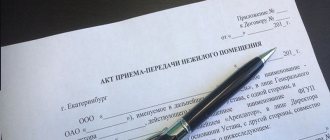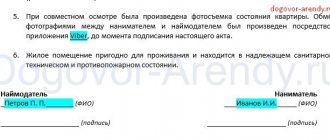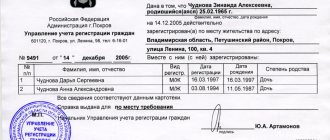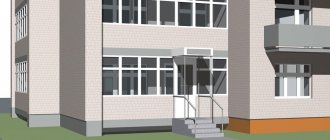When and why such an act is drawn up
Such acts are drawn up after inspecting residential or non-residential premises in order to confirm or refute the presence of damage and assess the damage caused. They also activate the state of an interior room or an entire building at a certain moment without reference to any event.
The act may reflect information about:
- results of visual inspection;
- measurements taken;
- taking samples for subsequent research in laboratory conditions;
- examination results.
Inspection reports are most important when:
- various real estate transactions (sale, rent, registration of collateral);
- violations of the rights of the property owner;
- emergency situations.
So, after completion of construction, the developer draws up an inspection report and hands it to the buyer of the premises. Subsequently, this document will serve as evidence that all construction and finishing work was completed in full and the new owner is satisfied with their results.
If the rights of the property owner are violated, an inspection report will be required to be submitted to the relevant authorities. And in emergency circumstances (flooding, fire, etc.), it will become the basis for compensation for damage from the persons responsible for the incident.
In this case, all acts of inspection of premises are divided into two groups: mandatory and optional. The first includes documents compiled during forensic examinations, investigations or investigations. The second includes those that accompany various property transactions.
What does the form look like?
The structure of the act resembles a statement without a header at the top in the right corner. The name of the document is indicated in the middle; under it, it is important to indicate the place where it is being prepared and the date of the inspection. Below you must indicate the full names of those involved in assessing the condition of the premises.
Information about the apartment or house is indicated - actual and legal address, what floor it is located on, total area, how many residential and non-residential premises it contains.
All detected damage, regardless of classification and reasons for its occurrence, must be described in detail in the document. If the commission members cannot find a compromise when a controversial situation arises, then this fact also needs to be recorded in writing. All participants sign below.
Sample of filling out a premises inspection report
Who draws up and signs the act
In order for the inspection report of a residential (or non-residential) premises to receive legal force, several people must be present when drawing it up. In addition to interested parties, there must also be disinterested representatives.
Depending on the act, experts, specialists, representatives of professional companies or government bodies, and neighbors may be involved as independent persons. After the act is drawn up, everyone who took part in the inspection must sign it.
Document structure
In order for the premises inspection report to be recognized as a full-fledged document, it must necessarily contain the following information:
- Name of the document (act) and its number.
- Date and place of compilation (name of the locality where the inspected object is located).
- The reason for drawing up the paper (major repairs, renting out, flooding by neighbors or any other).
- The name of the property based on the inspection results of which the document is drawn up.
- List of those performing the inspection.
- Complete data on whose initiative the inspection is being carried out (customer). This includes full name, identification data, place of registration, confirmation of ownership and other information.
- Type and address of the premises/building, all its technical parameters.
- Tools and methods used during inspection.
- Results of the inspection. Here, the participants in the process actually describe what they saw and, if necessary, assess the damage. If the inspection did not reveal any deficiencies, this fact is simply recorded in the act. If the purpose of the act was to reflect all the shortcomings, then each problem found must be described in as much detail and accuracy as possible.
- Signatures of all those present during the inspection.
In addition, the final part of the act must contain a note indicating that all interested parties are familiar with the results of the inspection and agree (or disagree) with them.
Commission members
Most often, a whole commission is called in to conduct a full inspection of the building. The composition of the commission group is selected based on the circumstances under which the control audit is carried out.
If this is the acceptance of a newly constructed building, then representatives of several companies that participated in the construction are called to the commission. And if a structure that has long been owned by a certain company is inspected (for example, after winter or an autumn inspection), then the commission will be formed from employees of the enterprise.
IMPORTANT! In any case, the commission should include at least 3 specialists, preferably from different professional fields. And if necessary, it may also include an independent expert.
Premises inspection report form
The current legislation contains fixed forms only for some variants of the premises inspection report. For example, an inspection report form for the procedure for deregistration of a building, structure, premises or facility.
In this case, the relevant act for 2020 is the one corresponding to the order of November 20, 2020 No. 861 “On approval of the form and composition of the information in the survey report, as well as the requirements for its preparation” and the changes made to this document on November 23, 2016 ( order No. 742).
Download the inspection report form
In most cases, there is no single form for the inspection report of premises - it depends on what the document is being drawn up for. Also, depending on the purpose of the inspection, the content of the document changes (however, the structure and basic data must remain unchanged).
Contents of the document
Of course, a lot depends on the specific object. For example, if we are talking about a capital construction project, then the commission should pay special attention to the load-bearing elements. After all, the strength of the entire structure largely depends on them. Information may vary depending on the type of object. But there is data that must be present in the act. So, the document can be divided into several parts:
- At the top you need to indicate the name of the document. The date of compilation is also indicated here. In addition, the locality in which the special commission carried out the inspection is indicated.
- The main part follows. The goals of this event are indicated in detail here, for example, transferring the property for rent, deregistering it, or carrying out major repairs. Also in this part of the act, mention should be made of the order, statement or other document that became the basis for the survey. All members of the inspection team are listed here and their positions are indicated.
- Below you enter information about the object, namely, its address, technical characteristics, and actions taken. It is highly desirable that this information be indicated in a separate paragraph. It is believed that this is how this important information is perceived better.
- After the descriptive part, the commission draws a conclusion. Summarizing their inspection actions, specialists can report that no damage was found at the facility, and it complies with the necessary norms and standards. This information will be quite sufficient. If deficiencies are found, it is necessary to describe them as accurately as possible. If there are several defects at once, it is better to indicate each of them as a separate item. In this case, possible reasons due to which malfunctions could arise are noted.
- Next, representatives of the commission must give recommendations on how to eliminate malfunctions, of course, if any were discovered.
- The final stage of filling out the document is the affixing of signatures by all members of the inspection team.
Sample act of inspection and categorization of an object in 2020
Certificate of technical inspection of the premises
Such a document is usually drawn up when selling or renting an apartment, as well as before starting repairs, reconstruction, and in a number of other cases.
During the initial transfer of the premises being put into operation, a template for the act is developed and issued by the developer. In addition to basic information about the buyer and developer, the date and place of drawing up the act, it should reflect:
- The degree of completion of finishing work (with finishing or not).
- Does the actual footage of the area match that indicated in the design documentation?
- Quality of joints and finishing works.
- Working status of communications.
If deficiencies are identified during the survey, all of them must also be reflected in the act and the time frame within which the developer undertakes to correct them must be indicated. An approximate sample act in this case looks like this:
Download a sample act
Another option for drawing up a technical inspection report for residential/non-residential premises:
Download a sample technical inspection report for residential/non-residential premises
Important! Once the buyer signs the deed, it will no longer be possible to ask the developer to correct the defects, so the inspection of the premises should be treated with great attention.
When inspecting a premises before repair work or reconstruction, the building inspection report is usually drawn up not as a separate independent document, but as an annex to the agreement or part of the documentation certifying the technical condition of the building.
Who does the work of drawing up the act?
To inspect the building, a special commission is created, consisting mainly of persons with an engineering or construction education.
The commission is created by an order that approves its composition, as well as the period of time allotted for carrying out the relevant work.
The basis for the inspection is the following circumstances:
- the need to conduct a routine examination,
- to determine the consequences of a natural disaster,
- before reconstruction or major renovation of the building.
Based on the results of the inspection, the commission members draw up a report, which is approved by the head of the enterprise or its chief engineer.
The commission's recommendations serve as the basis for the director to issue an order. It defines a set of measures necessary to eliminate the identified deficiencies.
Persons responsible for carrying out repair work within a certain period of time are also appointed.
Inspection report after an emergency
An inspection and a report drawn up based on its results after emergency incidents (flooding, fires, etc.) allows not only to identify damage and calculate losses, but is also the basis for collecting damages from the culprit.
Such an act is drawn up in free form, but in compliance with the basic rules. When inspecting the damage, both interested parties must be present (the victim and the culprit of the incident), as well as third-party observers and specialists who will help assess the technical condition of the premises and the damage.
In this case, workers of housing and communal services are responsible for drawing up the document and observing all the rules for its execution. After signing the act by all participants in the inspection, they certify the paper with the seal of their organization.
The act drawn up as a result of an emergency must necessarily indicate the cause-and-effect relationship between the flood (fire) and damage to things, decoration, and equipment. If necessary, for this purpose, as well as to establish the cause of the emergency, an examination is carried out. The results of the examination are also reflected in the act (or attached to it) as an addition.
Sample inspection report for buildings and structures
The inspection report of buildings and structures is a written document that records the technical condition of the structure at the time of the inspection.
A special commission, which includes engineers, builders, etc., takes part in its preparation.
Inspection report for buildings and structures: sample filling
A unified form is used to draw up the act.
It must indicate the date as of which the inspection was carried out. Next, the composition of the commission is listed, indicating the names of its members and the positions they occupy.
The act also indicates the number and number of the order by which the commission was created. It is necessary to indicate the period during which the commission must carry out its work.
The text of the act itself consists of a listing of the characteristics of the object, which make it possible to assess its technical condition.
To do this, use a special table in which you need to fill in the following sections:
name and location (including row, etc.) of the building or its individual structure,
description of defects identified during inspection,
the type of work required to eliminate them,
deadline for repair work, etc.
After the act is signed by all members of the commission, it is subject to approval by the director or chief engineer of a particular organization.
Who does the work of drawing up the act?
To inspect the building, a special commission is created, consisting mainly of persons with an engineering or construction education.
The commission is created by an order that approves its composition, as well as the period of time allotted for carrying out the relevant work.
The basis for the inspection is the following circumstances:
the need to conduct a routine examination,
to determine the consequences of a natural disaster,
before reconstruction or major renovation of the building.
Based on the results of the inspection, the commission members draw up a report, which is approved by the head of the enterprise or its chief engineer.
The commission's recommendations serve as the basis for the director to issue an order. It defines a set of measures necessary to eliminate the identified deficiencies.
Persons responsible for carrying out repair work within a certain period of time are also appointed.
Certificate of inspection of buildings and structures, accurate analysis of utility networks
Utility networks include the following systems:
water supply and sewerage,
heating,
electricity supply,
ventilation.
Inspections of utility networks are aimed at determining the quality of equipment operation, its technical condition and functionality.
In the process of work, the commission checks the level of compliance of engineering networks with the requirements of various regulatory documents and standards.
It should be noted that conducting this type of survey is the most effective way to determine the physical wear and tear of electrical networks, water supply, sewerage and other engineering systems.
Roof inspection
The roof or roofing is the upper part of the building, which protects it from various kinds of external influences, primarily precipitation.
It is the roof that makes it possible to maintain a stable microclimate indoors.
It is recommended that its examination be carried out systematically, which will make it possible to avoid the occurrence of serious problems that will require expensive repairs to eliminate.
During the inspection of the roof, it is necessary to inspect it in detail both from the outside and from the inside.
First of all, you should pay attention to the following:
type of roof and its covering scheme,
condition of the supporting base and protective coatings,
cornice design,
the presence of a watercourse and fencing system,
thickness and level of wear of insulating layers,
the condition of the protective and covering coating, as well as fastenings and sedimentary seams,
presence of defective areas.
Attic inspection
An attic inspection is primarily carried out to ensure that it meets technical standards and that the area is safe for the lower floors.
If the standards for its construction or operation are violated, then on the lower floors there is an increased level of humidity and stuffiness, which in turn leads to the formation of mold.
If the necessary measures are not taken in a timely manner, this situation will ultimately lead to the gradual destruction of the building.
When inspecting the attic, you need to pay attention to the following points:
integrity and strength of floors. They should not have cracks, holes, corrosion of metal elements, etc.
the condition and thickness of the insulation, the absence of bare spots in it,
level of vapor barrier in the room,
serviceability of the heating system, if one is installed in the attic.
Sample inspection report for buildings and structures
ACT dated August 14, 2016
for routine inspection of buildings and structures by the operating organization DomEspoClass LLC
Commission consisting of:
head of the operational department Mikhailov M.O.;
deputy Head of the Director for Technical Affairs Fedin N.P.;
chief engineer Stadnik V.V.;
chief power engineer Stepanova O.A.;
occupational health and safety engineer Vladimirov S.T.
Conducted a current inspection of: residential apartment building No. 47, building 4 on the street. Lomonosov, Astrakhan
Survey results:
— No defects were found in the foundation and plinth;
— No defects were found on the external walls;
— Three cracks the width of the wall on the first floor and stains on the walls were found on the internal walls (repairs are required on your own);
— On the façade, inscriptions were found on the stained glass windows and the front door (graffiti) – (it is necessary to carry out repairs on your own);
— No defects were identified in the stained glass glazing;
— No defects were identified in the drainage system (rain funnels, drainpipes);
— No defects were identified during the inspection of the roof;
— When inspecting the ceiling (attic, interfloor, basement), no defects were identified;
— When inspecting the technical floor, no visible defects were identified;
— On the interfloor floors, cracks were found on the floors in the amount of 25.7 linear meters (it is necessary to carry out repairs on your own);
— There are no defects on the first floor and in the basement;
— Windows in common areas (no handles in the elevator hall, 5 pieces, no handles in the trash can, 8 pieces). It is necessary to carry out repairs on your own;
— Doors in common areas (external: 26 pieces of glass are cracked, 12 pieces of handles are missing; internal: 9 pieces of springs are missing; 6 pieces of doors are damaged);
— No defects were found on the staircases;
— When examining the central heating system (radiators, thermal insulation, networks, shut-off valves), no defects were identified;
— When examining the hot and cold water supply system, no defects were identified;
— When inspecting the sewerage system (stop valves, network), no defects were identified;
— Power supply system: the electric meter for elevators in Main Switchboard 2 is faulty, the meter needs to be replaced (you must replace it at your own expense);
— There were no defects during the inspection of the elevator and garbage chute.
The commission decided:
The inspected building is in satisfactory condition and requires ongoing repairs.
Chairman of the commission _____________________ Fedin N.P.
Members of the commission _____________________ Mikhailov M.O. _____________________ Stadnik V.V. _____________________ Stepanov O.A. _____________________Vladimirov S.T.
Inspection report to determine living conditions
Inspection reports are drawn up not only to show the technical condition of the premises. If it is necessary to assess the living conditions of a family or child, acts on the state of living conditions are drawn up. Such documents are required for:
- receiving social benefits;
- adoption of a child from an orphanage;
- obtaining the status of a person in need of improved housing conditions.
Also, the preparation of such acts can be initiated by the guardianship service if there is a suspicion of physical or emotional distress in the families in which the children live. The content of such acts differs from those that reflect only the technical condition of the premises.
The most important part of such an act is the conclusion and conclusions of the commission that conducted the inspection.
Download the act on the state of living conditions
Basic rules for drawing up an act
Despite the variety of inspection acts, they all have a lot in common, in particular, the rules on how to draw up a document so that it acquires full legal status:
- When drawing up an act, you should use a business style of writing. Colloquial expressions and profanity are prohibited.
- The title of the document is always indicated in the center of the sheet. Next to it are the date (day, month and year) and the place where the act was drawn up (city).
- When listing members of the commission, indicate not only their full name, but also their position, as well as the name of the organization they represent.
- When checking the technical condition of engineering communications, it is necessary to certify their compliance with established standards and norms (with links to specific documents).
- Only the owner of the premises can act as a person affected by an emergency situation. The signature of any other person will not be the basis for compensation. Also, the signature of the person responsible for the emergency, but who is not the owner of the home, will be considered invalid.
At the same time, you can draw up an inspection report for the premises/building either in printed form or by hand. The main part can be filled out in descriptive form or in the form of a table. As for quantity, as a rule, inspection reports are drawn up in 2 copies. However, if there are more than two interested parties, the number of copies is increased (one for each interested party).
General requirements for the content of the apartment inspection report in 2020
The deed is usually drawn up in the form of a descriptive document.
Although, for greater convenience, some format the document in table form. This is especially convenient when a large amount of information is entered into the act. As for the volume, it all depends on the complexity of the apartment. The larger it is, the more information will be available during inspection. The scope of the act is also influenced by the goals pursued by this inspection. The larger they are, the broader the document becomes. Important information that must be contained in the document includes information about the real estate that was subject to inspection. The responsible persons who worked directly at the site are also indicated here. Naturally, the commission must draw conclusions. If there are any comments, they are recorded in the act. If there are none, it should be written that there are no comments.
The document must have several copies. Each interested party must receive one copy. All of them have the same legal force; accordingly, autographs of representatives of each party must be affixed here. If an organization that uses a seal in its activities takes part in a transaction, it puts the stamp on the document. It must be remembered that a correctly drawn up act will become powerful evidence in court proceedings.
Instructions for filling out the act
Despite the fact that the document is drawn up in free form, there are general rules for office work. Usually there are no difficulties with filling out the act. The document is filled out step by step:
- You need to start by filling out the “cap”. The name of the document, city and date of compilation are indicated here.
- The composition of the inspection team is indicated. This is not only the name of each specialist. It is necessary to indicate what organization he represents and what position he holds.
- The fact of inspection of the premises is confirmed below. You must indicate the exact address where it is located. If the apartment is on the balance sheet of some company, this should also be mentioned.
- Next, members of the review team must draw conclusions. If no defects are found, it is necessary to indicate that the condition of the premises is satisfactory.
- It would be useful to point out that there are no comments on the electrical equipment and the general condition of the apartment.
- The final stage of filling out the document is affixing autographs of all responsible persons. Moreover, the signatures must have a transcript.
It is worth noting that this is only an approximate example of filling out the document. At the discretion of the responsible persons, you can specify additional items in which more detailed information will be displayed. For example, you can imagine a situation where members of the inspection team discovered any problems or malfunctions. In such a situation, they must be written down in great detail. Here you need to understand that even the smallest complaints must be described. After all, they are the ones who can cause disagreements between the parties. For example, when renting out an apartment, the commission will not take into account torn linoleum. If the tenant does not notice such an oversight, it will be considered that he received the apartment in perfect condition. Upon its return, the owner may demand compensation for damage to which, in fact, the tenant has nothing to do. Therefore, even minor details must be displayed in the document.
Mistakes when drawing up an act that should be avoided
The most common mistakes when drafting a document are:
- Lack of passport data of interested parties.
- Lack of access to inspection by specialists/experts.
- Non-obviousness of facts (lack of cause-and-effect relationship). For example, damage to furniture and puddles on the floor in the absence of signs of flooding on the ceilings and walls.
- General formulations when indicating damage as a result of an emergency. To correctly calculate damage, it is necessary to clearly and completely indicate the brands of household appliances, the quality of materials and other characteristics of the affected objects.
In addition, an act drawn up after the actual elimination of the cause of the accident will be considered invalid.








